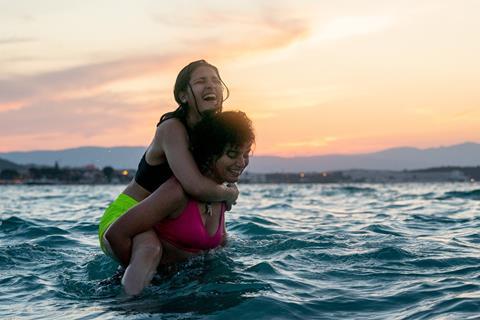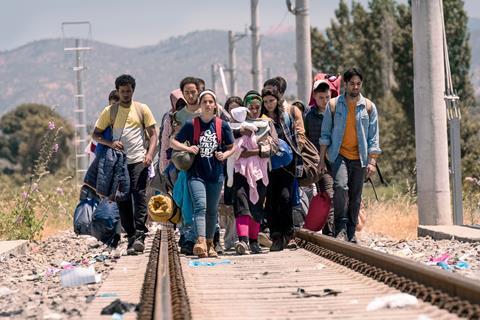Sally El Hosaini’s second feature and Toronto opening film The Swimmers brings an intense level of authenticity to the refugee drama and tale of Syrian sister heroes.

Filmmaker Sally El Hosaini had already turned down two scripts from Working Title when the UK production company sent Jack Thorne’s The Swimmers screenplay to her London agent Matthew Bates at Sayle Screen for her to read.
Since making her 2012 debut feature My Brother The Devil, El Hosaini had been principally focused on her own projects including a still-unmade feature about cult leader Jim Jones — and so her initial reaction to this latest opportunity was, “Oh no, I’ll have to say no to them again.”
As she explains, “I was just very tunnel vision on my project at the time. So Matthew was like, ‘Look, you really ought to read it. You don’t want them to think you’re just saying no.’ So then I read the script. It sounds clichéd, but when I got to the end, I knew I had to do it.”
The Swimmers — the opening gala of this year’s Toronto International Film Festival — tells the true story of Syria’s Yusra Mardini, who had trained from childhood to become a professional swimmer, and whose Olympic ambitions were imperilled when the civil war in Syria broke out in 2011. Together with her elder sister — and fellow competitive swimmer — Sara, she joined the throng of refugees fleeing Syria, eventually arriving as asylum seekers in Germany after a perilous journey.
Producer Ali Jaafar (King Of Thieves) brought the story to Working Title nearly two years prior to the publication of Yusra Mardini’s 2018 memoir (Butterfly: From Refugee To Olympian — My Story Of Rescue, Hope And Triumph), and the film is produced by Tim Cole (Wild Bill), Tim Bevan, Eric Fellner and Jaafar. Stephen Daldry, who at one point had been attached to direct, is among the executive producers.
Heroic status

Boarding the project in late 2018, El Hosaini quickly saw that Thorne — a multiple Bafta TV Awards nominee and winner for dramas including National Treasure and The Fades — had avoided the simple “refugee-to-Olympian” narrative. Instead, “It was about Sara as well, and suddenly it became about the love story between sisters. The fact that it was about two heroes — the obvious hero in Yusra and the unsung hero in Sara — was just so inspiring to me.”
The filmmaker — who was born in Wales but grew up in Egypt until the age of 16 — felt a personal connection. “On screen, you rarely see young women like these that are modern, bilingual, liberal. A lot of Arab women are portrayed as victimised or overly religious. Every Arab city in the world has young women like Yusra and Sara.
“And it was the idea that war turns everything on its head. These women are forced to take their lives into their own hands because of the chaos. Inside the film, I saw this incredible emancipation and freedom. It was something I could relate to.”
El Hosaini felt able to push the characters in a way that perhaps Thorne felt inhibited to do. “When you don’t know a culture, maybe you want to treat it in a respectful way,” she explains. “I felt I gave Jack the confidence to make the sisters at times even a bit more unlikeable. There was an irreverence I wanted to bring to it, and a sense of humour.”
Along the way, Thorne invited El Hosaini to receive a joint screenplay credit. “Jack had built such a wonderful structure in the story, I was just window dressing and roughing it up a little bit,” says the filmmaker. “But it was a true collaboration between us.”
Netflix boarded and greenlit The Swimmers, but El Hosaini would not have a film unless she found her Mardini sisters — and she turned to Shaheen Baig, who had cast My Brother The Devil. The Bafta-nominated casting director worked with casting associates across multiple countries, initially looking at Syrian nationals, many of whom — like the Mardinis — had fled the conflict.
“What became apparent was that the paperwork situation for them to come and film in the countries we needed was difficult,” says El Hosaini, who shot in Turkey, Belgium and the UK. “They had various degrees of refugee status and legality and red tape.”
El Hosaini was next looking for young women who could speak fluent Arabic, preferably from Levantine countries bordering Syria, and who could also handle scenes in the English language.
In Paris, the team found its Sara Mardini — the film’s rebel spirit — in the shape of French-Lebanese actress Manal Issa. Then they learned about Issa’s younger sister Nathalie — who was studying literature, and far from sure she wanted to act. She was tempted to come in and screen-test alongside Manal. “When I saw them together and their chemistry… It was just fantastic,” says El Hosaini.
The cast also includes James Krishna Floyd — the filmmaker’s real-life partner, who starred in My Brother The Devil. The pair will next collaborate on the feature Unicorns, co-directing from a screenplay by Floyd, with Trudie Styler and Celine Rattray’s Maven Screen Media and Philip Herd’s Chromatic Aberration financing and producing.
El Hosaini calls Netflix “the perfect people” to make The Swimmers — for example, understanding her desire to have much of the dialogue in Arabic. “That was something that wasn’t there initially, but I felt was so important,” she says.
From the Netflix team, El Hosaini worked with VP of international film David Kosse and director of original film Racheline Benveniste. “As a filmmaker, you end up fighting for authenticity a lot of the time, or I certainly do. And there wasn’t even a fight with them. They understood from the get-go what I was trying to do with [the Arabic language]. Netflix has a global audience, and they think in that global way.”
World affair

The Swimmers shot in the UK (London’s Olympic pool stands in for Rio de Janeiro’s equivalent, where the drama climaxes) and Belgium (Lites water stage and studios in Brussels), but the majority of locations were sourced in Turkey, standing in for Syria, Greece, Macedonia, Serbia, Hungary, Germany and Rio’s beaches, as well as for Turkey itself.
“When I first came on board, there was this assumption we would go to Morocco, because a lot of the Middle East is filmed in Morocco, but that wasn’t the most authentic choice,” says El Hosaini. “As soon as we went to Turkey, we realised we could absolutely shoot this number of countries there. And the crews are fantastic.”
In discussions with director of photography Christopher Ross (Danny Boyle’s Yesterday), El Hosaini shared an ambition: “I was mindful the images people usually see of refugees, and in dinghies, are things we see on TV. I wanted to make this as an emotive and cinematic experience as possible, and to put the audience in the shoes of the girls, and as a traveller on the journey alongside them.”
Ross shot using Cooke Xtal Xpress lenses. “These handmade lenses are full of imperfections, and are as far away from the TV news images as you can get,” says El Hosaini.
The road-movie nature of the shoot was arduous for the cast and crew, as they constantly moved between locations, and involved 58 shooting days across three months in late spring/summer 2021. “Chris needed to be there with the camera on the journey, in the dinghy right next to them, being knocked about, standing in the sea. Walking in the baking heat along the train tracks, on the rocky uneven ground of the wooded hill, being bitten by mosquitoes. He said more than once that this was the hardest film he’d ever shot, and he lost a stone [6kg] in weight.”
When it came to shooting in the Aegean sea — water tanks were used for night shoots — the film reaches its most intensely dramatic moments. Among supporting artists in the dinghy, El Hosaini had cast a number of refugees who had made that same treacherous journey.
“We did all the daytime sea stuff for real,” she says. “The level of bonding that happens, because the sea was choppy. When the actors are vomiting, they’re really vomiting. You can’t have a break when you’re out in the middle of the sea.
“Having people on that boat who’ve done the journey just set a tone… This sense that everybody was very humbled, and prepared to try to understand and experience what so many people are still going through.”























No comments yet